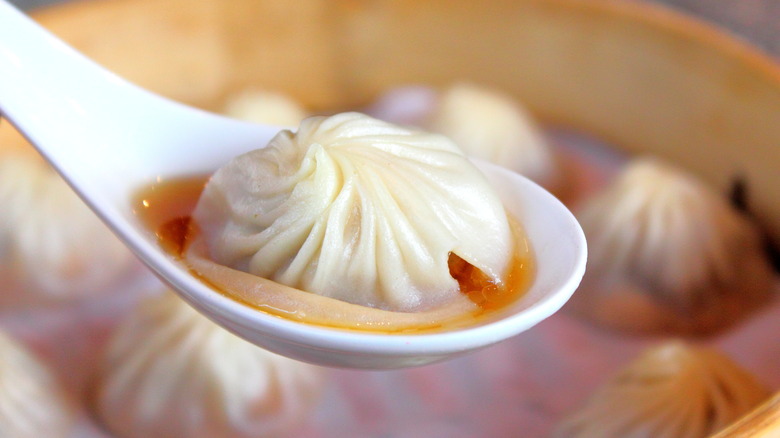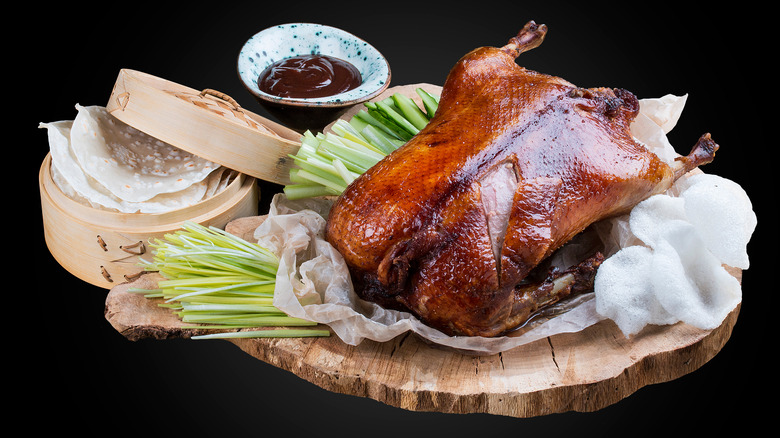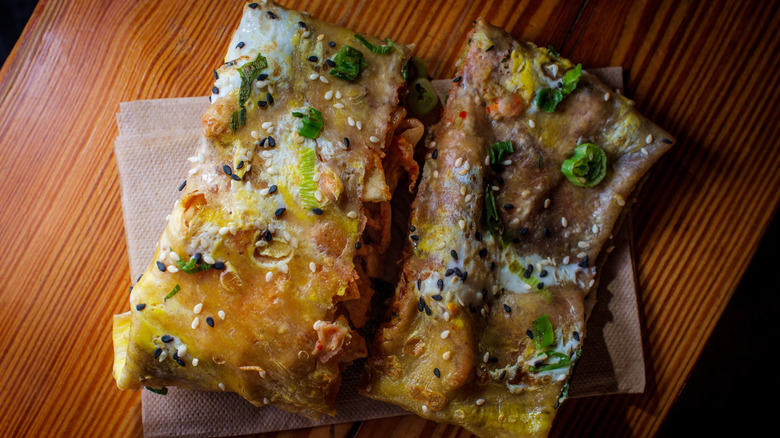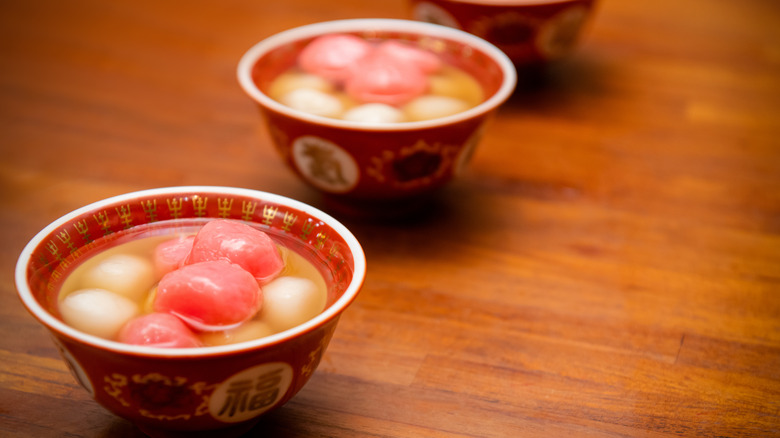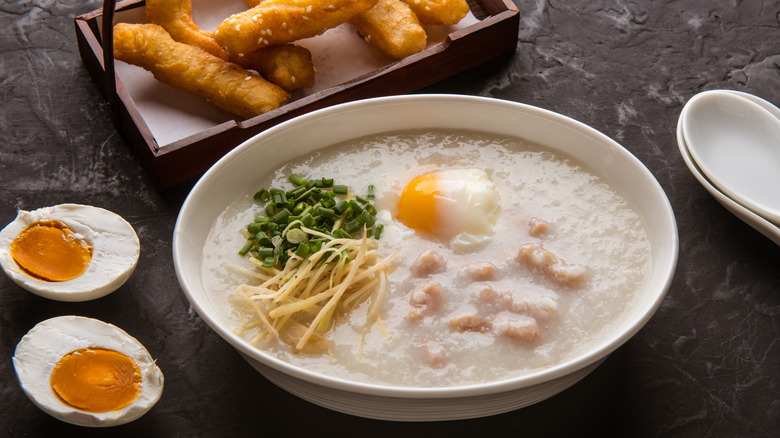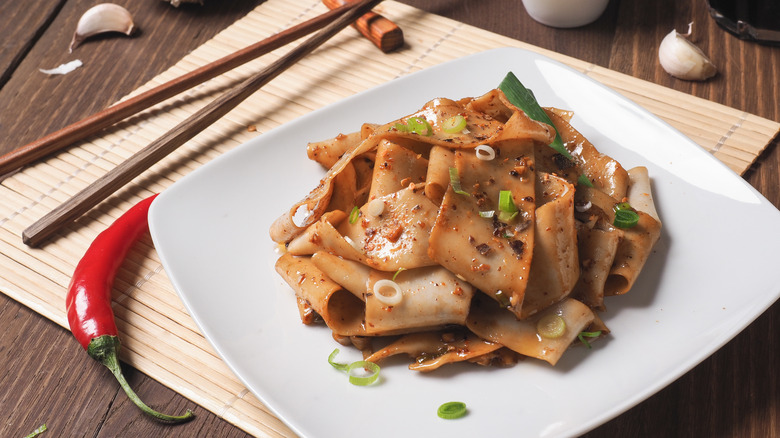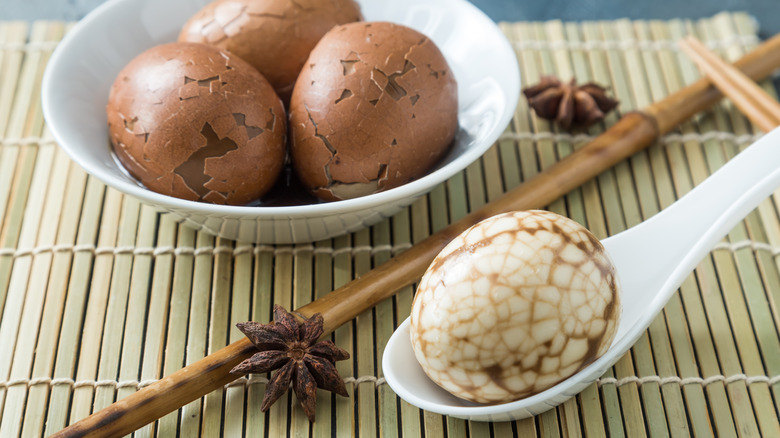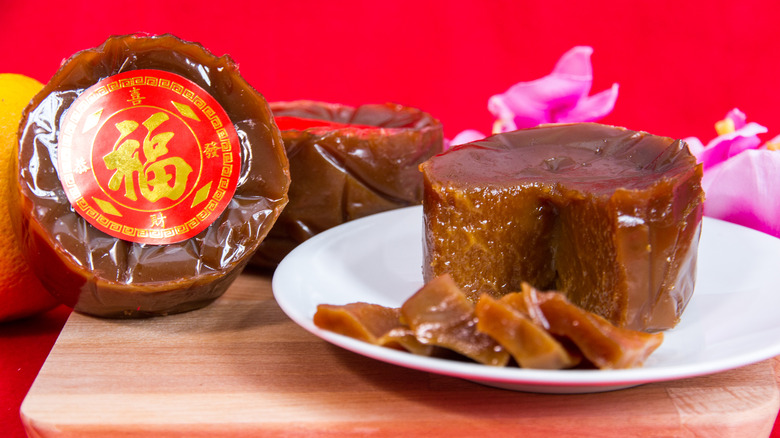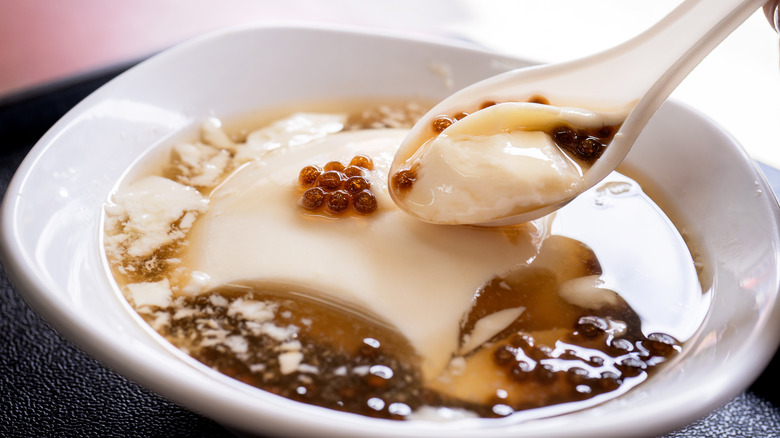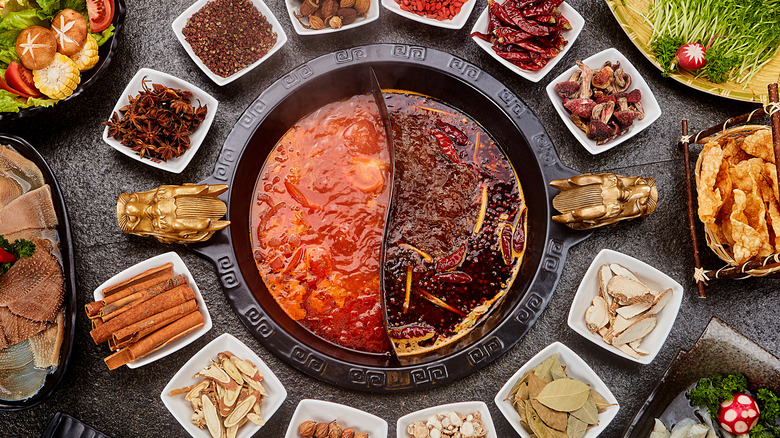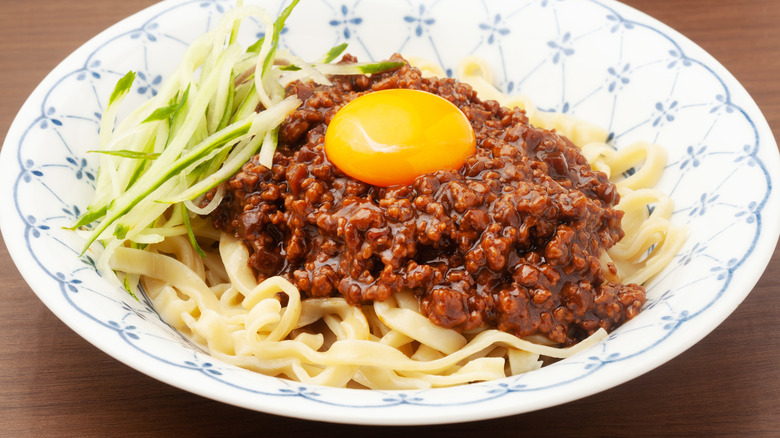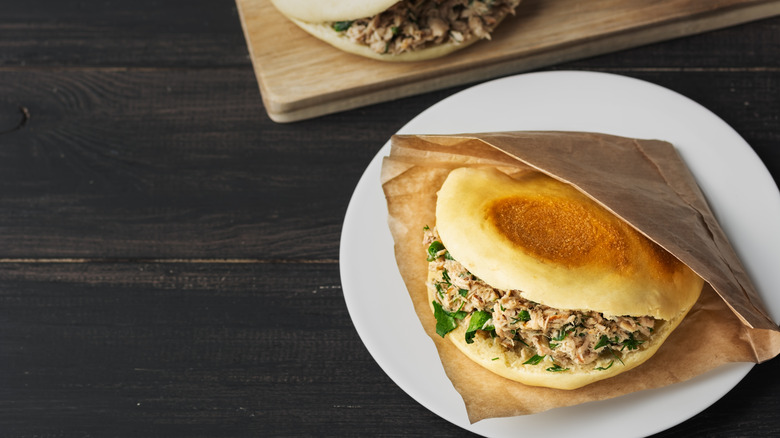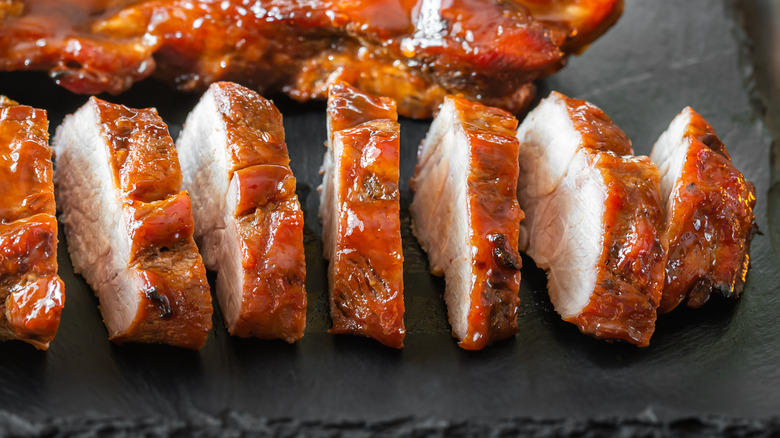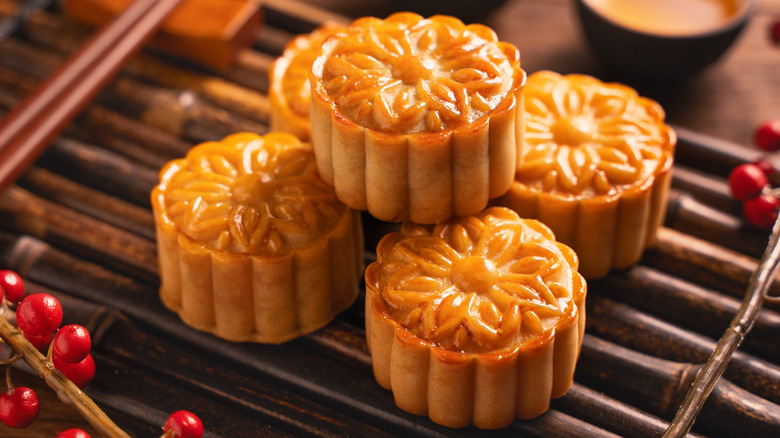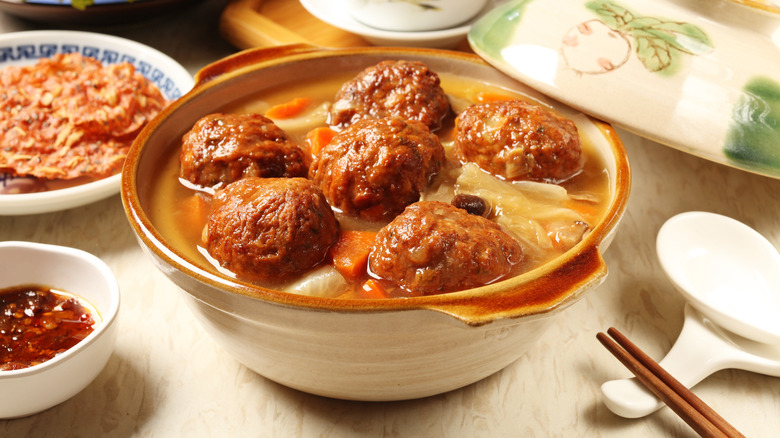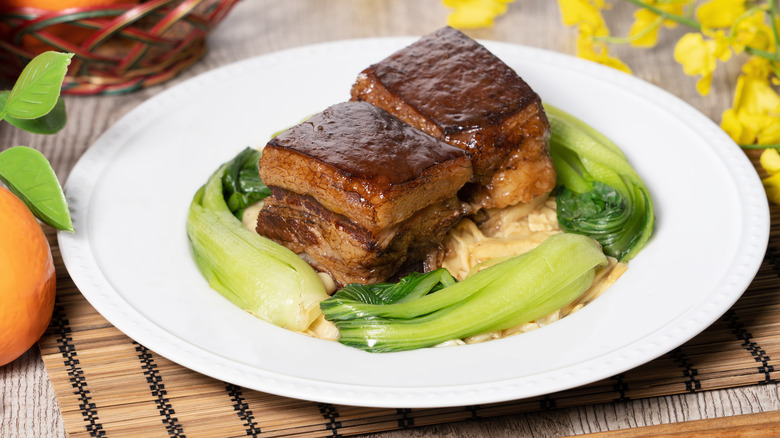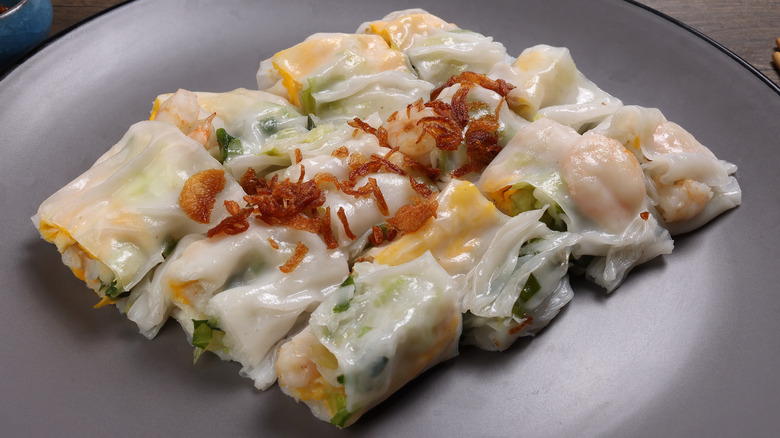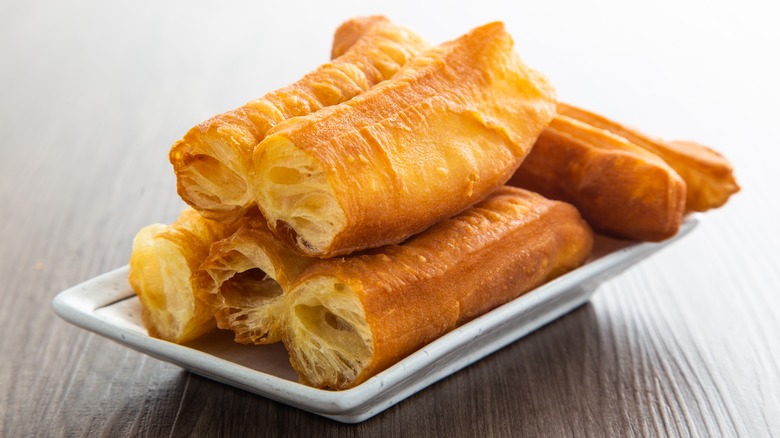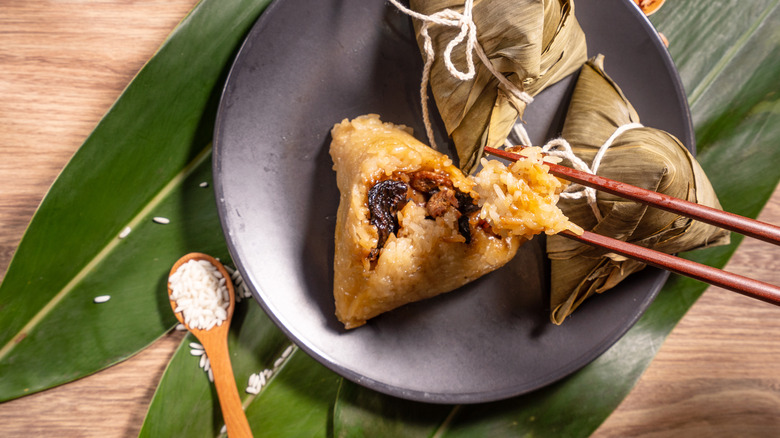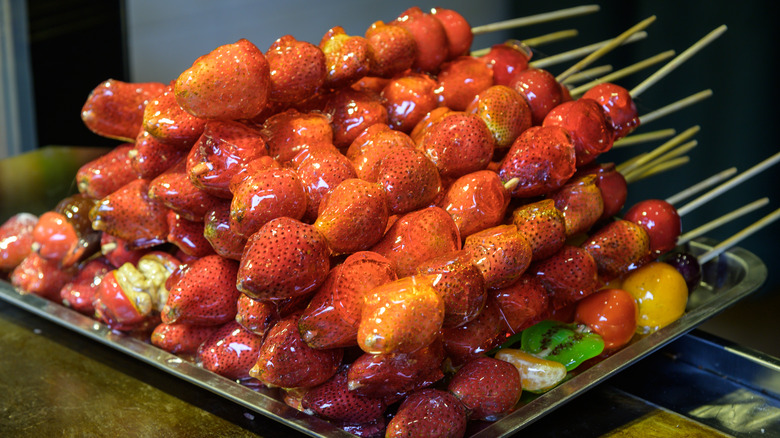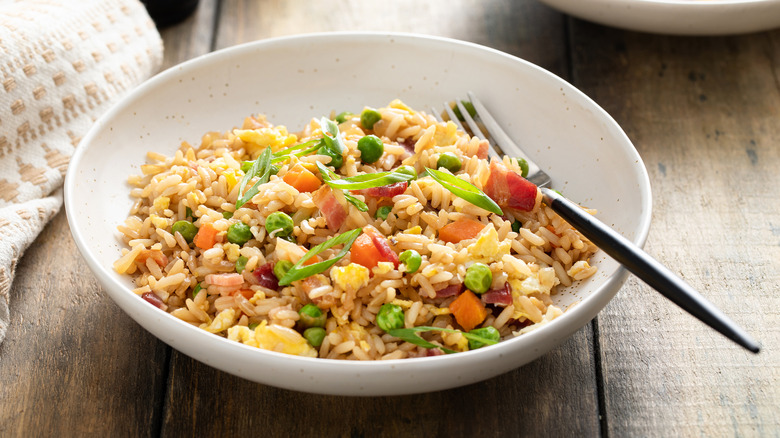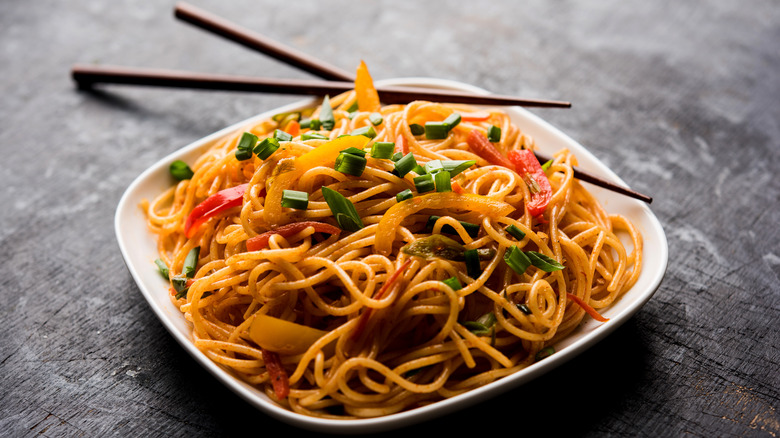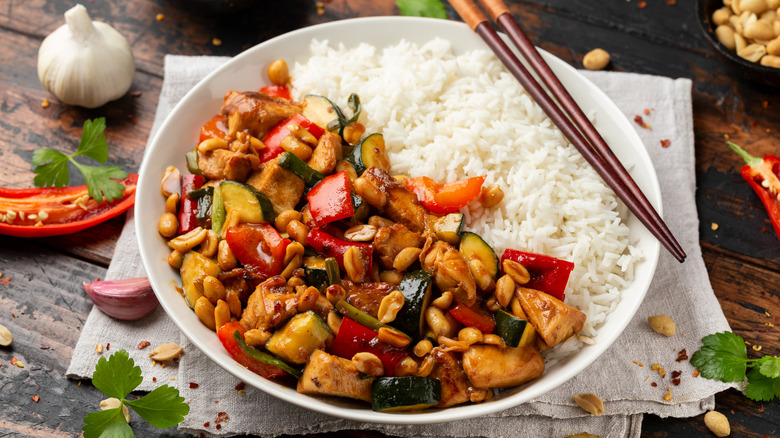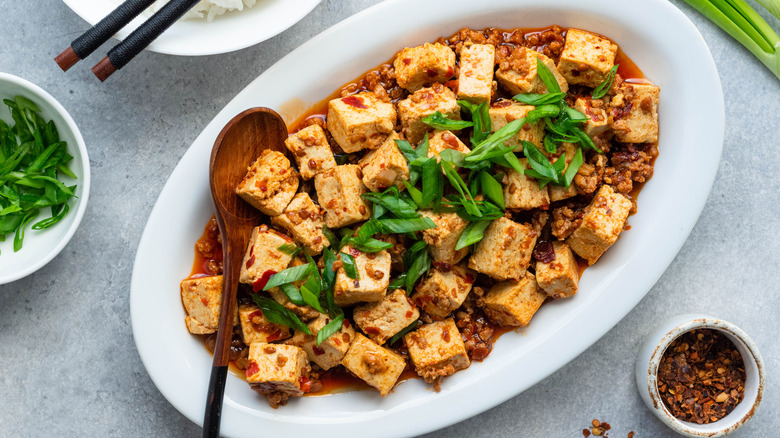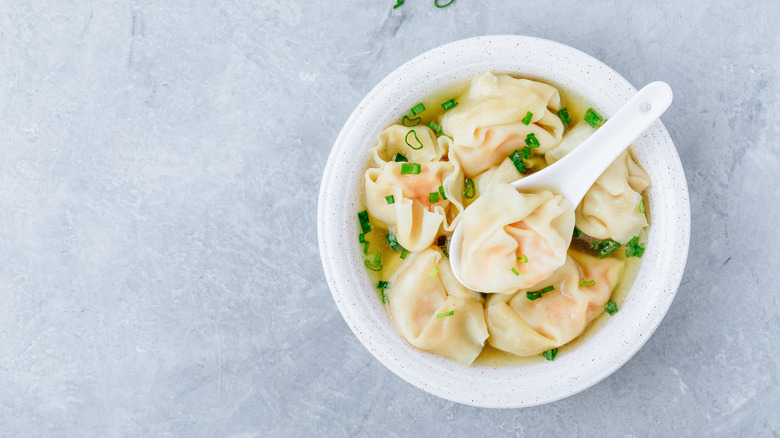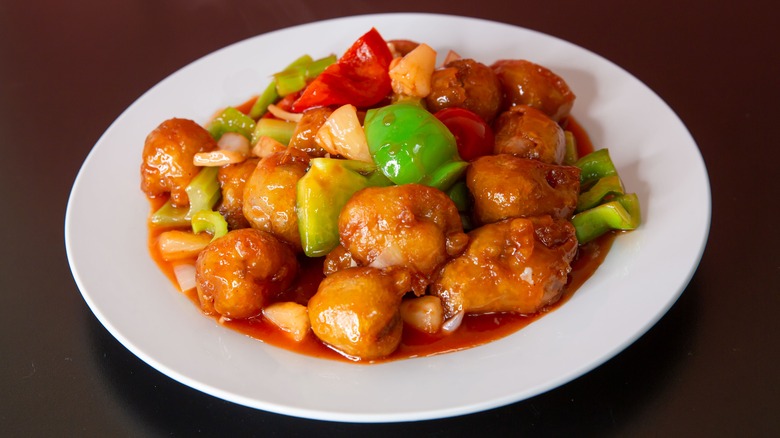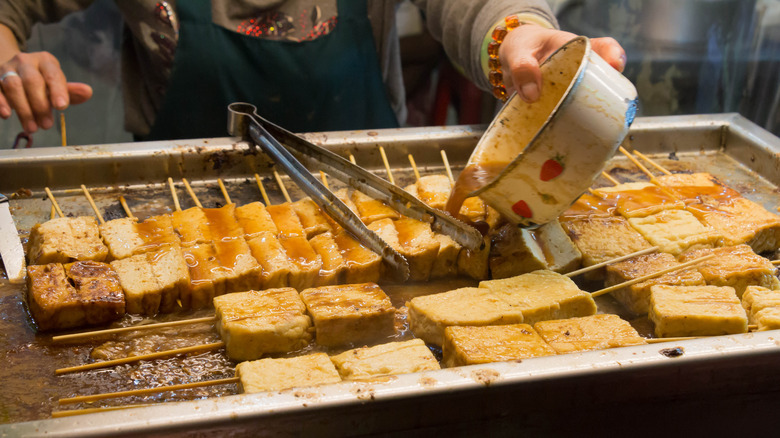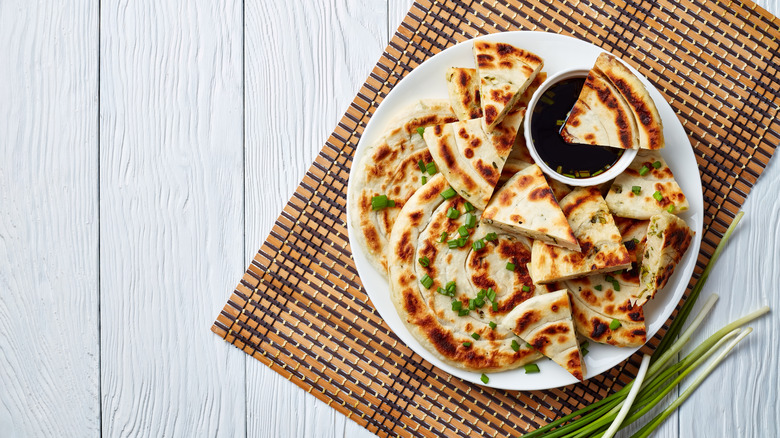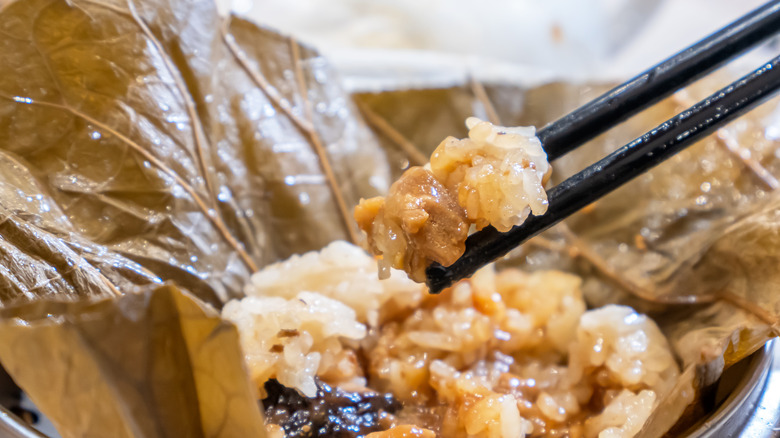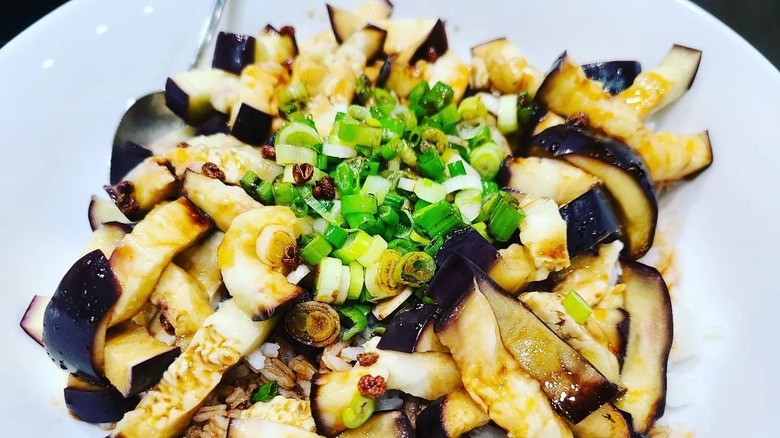30 Chinese Dishes You Need To Try At Least Once
More people reside in China than in any other country in the world (via Statista). Coupled with the fact that China happens to be among one of the largest countries by area, it's safe to say that Chinese food is far more illustrious than the orange chicken that many in the U.S. associate it with — a culinary invention that is entirely American, thanks to Panda Express.
Even within the culmination of what is considered to be Chinese food as a whole, are various regional Chinese cuisines, each influenced by varying climate, terrain, and its people. The simple, salty, and vegetable-less foods like clear broths come from the regions of Northern China; light and seafood-heavy dishes like dim sums come from Eastern provinces; and the West eats more halal food due to a Muslim and Tibetan influence in the region. The hot, spicy, and fiery red foods that are synonymous with Sichuan cuisine are mostly eaten in Central China. Such is the diversity of Chinese food.
Chinese cuisine is vast and its dishes plentiful, but if you were to narrow it down and couldn't figure out where to begin, this list goes over Chinese foods that you should try at least once in your lifetime — if not a thousand times more.
Xiao long bao
There are a great deal of steamed dumplings in Chinese cuisine, each more delicious than the other. Xiao long bao, however, has been deemed by the Shanghai government to be a protected national treasure since 2006. Xiao long bao was invented by a certain restaurant owner Huang Mingxian who, baffled by the sheer number of steamed buns in 19th century Shanghai and their popularity, set out to make one that would stand apart from all others. So, he made a pork-based broth, turned it into a jelly using gelatin, stuffed the solidified broth cubes inside delicate buns, and steamed them. The result was a small bao that would burst into warm soup when poked into, which is supposed to be slurped quickly, and best eaten hot off the steaming basket.
Because the slightest incision can result in a soupy spill all over your plate or leave you with burning hot liquid in your mouth, xiao long bao eating requires you try and employ a particular tactic. First, gently transfer the bun into a spoon and then carefully take a small bite off the top of the dumpling. Let the steam from the liquid soup inside cool down, slurp away all the soup, and then pop what's left of the dumpling into your mouth.
Peking duck
Peking duck when brought whole to a table looks like a food delicacy that belongs more in one of the many portraits of feasts and banquets thrown by mid-century kings and queens. It turns out, the roasted duck has long been a favored dish of Chinese emperors. The Qianlong Emperor of China is even said to have eaten eight Peking ducks over the span of two weeks at some point in 1761.
A well-known Chinese food today, the roasted duck is much sought after perhaps for its glossy brown and crisp skin, widely considered to be the best part of the entire dish. The traditional method of roasting a Peking duck involved hanging ducks over burning wood in brick ovens, which required chefs to be attentive to the needs of the roasting duck. Now, the roasting is often left to an oven. The roasted duck is then sliced using a special knife called pianya dao, and a single duck can produce as many as 100 trimmings under a skilled chef. The trimmings are accompanied with thin pancakes in which the duck can be rolled into alongside leeks, cucumbers, pickled vegetables, and a sauce.
Jianbing
Each country has a beloved breakfast item that it can call its own: France has croissants and coffee; the UK has its full English; and China has jianbing, a breakfast crepe bought fresh off a street vendor. As legend goes, a Chinese army at some point in history found itself robbed of all belongings, including cooking vessels and food items. Left with a mishmash of ingredients, the army made a thin batter from wheat and water, spread it like a crepe on shields placed over a fire, and put what ingredients they could find on the crepe.
Today, street vendors in China — and eateries like the Jianbing Company in Brooklyn — layer a beaten egg onto the crepe, sprinkle in a mix of cilantro and green onions, layer fermented vegetables, bean curd, and chili, and cover the fillings in hoisin sauce. Often, a crisp cracker called baocui is added for crunch. Jianbing is then wrapped, rolled, sliced, and served just as morning hunger pangs begin to take over.
Tang yuan
Tang yuan, or yuanxiao as it goes by in Northern China, is a sweet dish of rice balls with rich symbolism in Chinese festivities. Each year, the Chinese celebrate a two-week-long Chinese New Year, which ends with the mesmerizing Lantern Festival. While families gather to light lanterns, they also gather to eat delicious Chinese foods, in particular tang yuan — a colorful dessert of bite-sized chewy rice balls that symbolize harmony and reunion. In fact, when spoken out loud, the sound of the word tang yuan sounds the same as "tuán yuan," which is the Chinese word for reunion.
Although tang yuan can sometimes be prepared with a savory filling of walnuts, peanuts, and minced meat, more often than not it is filled with a sweet paste of sesame seeds or red bean, lard, and sugar. The rice balls are either steamed or fried and served swimming in a ginger, sugar, and water syrup sprinkled with osmanthus flowers. Even the round shape of the balls, the pink or red-tinted color of the dough, and the bowl in which they are served are all interlinked with joyous symbols associated with the beginning of a new year. It is also believed that the rice balls should be eaten in pairs of two — a sign of good luck.
Congee
If you're ever in need of food that is comforting for both the body and the soul, think of it as the perfect occasion to swap chicken soup for a warm bowl of congee. Congee goes by several names in Asia but in China, it is the very definition of Chinese comfort food. Tobie S. Meyer-Fong, a professor at Johns Hopkins University, told The Washington Post that the first food babies taste in China is often congee and that the porridge-like bowl is eaten by everybody — seniors with trouble chewing, those down with a stomach bug or really, anybody even just nursing a hangover.
Congee is usually made from rice but can sometimes be replaced by other grains because the dish serves a dual purpose: that of being a comfort food as well as being a dish that can help stretch limited groceries in dire times. Depending on the stock of the pantry and the luxury that it offers, rice can be boiled in water, milk, or coconut milk, cooked with chicken, eggs, or herbs, and can be served plain or with accompaniments like meat, seafood, pickled veggies, and a salted duck egg.
Biang biang noodles
While rice predominates foods that have come from the southern regions of China, wheat-based items like noodles and dim sums are staples in foods of Northern China, thanks to a stark difference in terrain, climate, and agriculture between the two regions. This is why you've likely tried plenty of noodles from Chinese takeouts already, but it is biang biang noodles that should be next on your list.
The word biang, much like hiss and bang, is onomatopoeic. It doesn't exist in official dictionaries and yet, it is used as a name for a noodle popular in China. In reality, biang biang noodles are made by hand-pulling long ropes of dough and smacking them against counters. The sound that the noodle creates upon being smacked is "biang," hence the name biang biang noodles.
The chewy wheat noodle is wide enough to be closer to a belt than a noodle in appearance and is often so long that a single noodle is enough for one serving. It tends to come dunked in hot chili oil along with a leafy vegetable like bok choy.
Tea eggs
At this point, it feels like we already have done everything with eggs that we could possibly do. We bake them, fry them, poach them, pickle them, and use them in all sorts of cooking — there's only so much more that an egg can do to surprise you. But these tea eggs just might do the trick. A popular choice of snack in parts of Southeast Asia, tea eggs are often sold by street vendors at markets and can even be found at convenience stores.
Tea eggs have an intricate marbled appearance which forms after a sizable investment of time. First, an egg is hard-boiled and cracked, following which the egg is left to slowly cook in a liquid of soy sauce, tea leaves, and spices such as cinnamon, star anise, and Sichuan peppercorns. After several hours of cooking — days even — the liquid's color and flavor infuses the egg making it very flavorful and leaving behind a marbled pattern on the egg once it is shelled. Tea eggs are often eaten as is or topped on a bowl of another Chinese food to try on our list: congee. Because eggs are considered to be a symbol of fertility in Chinese culture, tea eggs are often served at Chinese New Year festivities.
Nian gao
Chinese New Year celebrations see the preparation of a wide array of delicacies, each with a symbolic meaning of its own. Nian gao — a sweet and sticky cake made from glutinous rice flour — is mostly eaten during Chinese New Year celebrations as a symbol for growth and prosperity. According to folklore, nian gao is served to effectively shut the mouth of the Kitchen God present in all households (with the help of the rice cake's stickiness) to stop him from making any complaints about you to the Jade Emperor at the end of the year. Nian gao pretty much prevents you from being on the Jade Emperor's naughty list.
The preparation of nian gao varies in each region of China. In the north, the cake is usually white or yellow, steamed or fried, and has a sweet taste. In the east, slices of nian gao are often stir-fried and served alongside scallions, meat, and cabbage. In the south, the Cantonese version of nian gao is stickier and darker in color due to the use of brown sugar. In some parts, the rice cake is stuffed with peanuts, dates, seeds, and nuts or with a red bean paste and jujube paste. They can be eaten plain, dipped in egg and fried, steamed in banana leaves, or served with shredded coconut on top. Regardless of its fillings and variations in flavor, nian gao is a food almost always sold in complete festive gear. The cakes are often wrapped in red cloth and ribbons and packed in plush boxes or hampers with New Year wishes written on them.
Douhua
It is said that tofu originated in the Han Dynasty of China when a young prince went about mixing brine and soybean milk in the hopes of creating a food that would immortalize his people. While he may not have succeeded with the immortality bit, his creation — tofu — is certainly enjoyed not just by his people in China, but all over the world by many. Aside from being used in stir-fries and broths, tofu is also eaten as a pudding in China.
A greatly preferred snack, douhua or tofu pudding can be found in various forms across the country. In its sweet form that is mostly preferred in the south, the silky soft tofu pudding is often served in a sweet sugar, water, and ginger syrup or simply served sprinkled with sugar. In northern China, douhua is served in a gravy of eggs, mushrooms, and bamboo shoots. In the heat-loving province of Sichuan, the pudding is dunked in chili oil and served alongside cold noodles in the summer or dan dan noodles in the winter.
Hot pot
Hot Pot is a dish designed to be eaten in the company of a group and nearly impossible to eat alone; you could try, of course, but it wouldn't quite be the same. Indeed, hot pot, or huo guo, is more so an eating experience than a dish, at the center of which is a huge pot of hot broth perched over some sort of burner and is accompanied by several smaller plates of dipping ingredients. Eating involves sharing the ingredients and cooking them yourself in the bubbling stock or broth at the center of the table.
A typical broth is made of chicken, ginger, and aromatics but its Sichuan version can be much spicier with the addition of the region's signature peppercorns and red chilies. Dipping ingredients on the side include all sorts of small foods, such as sliced meats, meatballs and fish balls, noodles and rice cakes, as well as veggies. These ingredients are then accompanied by an equally vast array of sauces.
While the exact broth, ingredients, and sauces you get may depend on the "theme" of the hot pot that you're ordering, the eating process more or less remains the same. Strategically pick your ingredients (keeping the general cook time of each in mind), dunk it in the simmering broth till it cooks, dip it in your choice of sauce, and enjoy. Keep repeating the process till the many plates are empty or till your stomach can't fathom eating another bite of food.
Zhajiangmian
Zhajiang in Chinese translates to fried sauce and that's pretty much the essence of Zhajiangmian. A dish from the northern region of China, and popular in Beijing in particular, Zhajiangmian mainly has two ingredients: a sauce and wheat noodles. The sauce depends on two pastes — gan huangjiang, which is a salty fermented paste of yellow soybeans, and tianmianjiang, a sweet and syrupy paste of soybeans and wheat flour. Together, the pastes are cooked on high heat to make a sauce that is sweet, salty, and umami at the same time. In Beijing, however, often only gan huangjiang is used and the sweet tianmianjiang is left out.
Zhajiangmian sometimes has a third ingredient — fried diced pork. Additionally, raw or blanched vegetables like cabbage, edamame, and bean sprouts are added on top for crunch. In northern China, chewy zhajiangmian noodles are often handmade and sliced into strips of fairly thick and long noodles.
Rou jia mo
What xiao long bao is to Shanghai, rou jia mo is to Shaanxi. Deemed in 2016 to be Shaanxi Province's Intangible Cultural Heritage, rou jia mo literally translates to meat in a bun and looks like a hamburger or a sloppy joe.
Dating its origin back to the Qin dynasty of 221 BC to 207 BC, rou jia ma is said to have originated in the Shaanxi province and is a popular snack of choice bought from a street vendor and eaten on the go. The hamburger has two components: a bun and a filling. The bun, or mo, is a chewy and pillowy mix of steamed or baked wheat flour, yeast, and water. The filling, la zhi rou, is usually made from shredded pork belly cooked in spices like ginger, cloves, and star anise.
Char siu
Char siu simply means barbecued pork but there's a lot that goes into the making of this classic Chinese BBQ food. The first mentions of char siu seem to have appeared in royal cookbooks of the Zhou dynasty when barbecuing and grilling were particularly popular in China. Today, some 3,000 odd years later, char siu is thought to be the very symbol of what comfort food means in Cantonese cooking and one you should try at least once.
Traditionally, char siu pork used to be grilled on skewers. However, with time, char siu's cooking method, the recipe for the pork marinade, and even the choice of cuts have greatly evolved, and today differ from chef to chef. While pork tenderloin is preferred, pork belly, neck, and shoulder can all be used to make char siu. The pork is marinated in seasoned hoisin and soy sauce, and a final glaze of maltose gives char siu its shiny appearance. Cuts of char siu are then eaten sandwiched between baos, served on top of a rice or noodle bowl, or added to fried rice.
Mooncake
If you've ever taken part in the Chinese Mid-Autumn Festival, you will have noticed tiny cake-like treats with beautiful decorations and inscriptions on top. These little cakes have a rich history sprinkled with colorful legends and hold great significance for the autumn celebrations. The round cakes have a pastry skin with a paste of jujubes, lotus, or sweet red beans for filling. The filling can also have fruits, nuts, seeds, salted egg yolks, and occasionally, the savory ingredient like ham.
The cakes are thought to be Chinese food symbols of family reunions and happy times. At one point, they were even thought to be perfectly suitable presents for the emperor of the Tang Dynasty to give to visiting nobility, perhaps because of the myths surrounding the mooncake. According to one legend, the Chinese goddess of the moon, who happens to be at the center of the Mid-Autumn Festival, accidentally consumed an immortality potion. Separated from his wife, her grief-struck husband placed her favorite food items in front of the moon in her memory, one of which was the mooncake. As for the Chinese characters stamped on the crust of the mooncake, tales suggest that they were supposed to be hidden messages conveying all sorts of secrets between the people of the Ming Dynasty. Regardless of the legend behind the mooncake that you think is most believable, when you try one for yourself, remember to cut a mooncake into several pieces and share them while eating. Eating an entire mooncake alone is very much frowned upon.
Shizi tou
Shizi tou is often referred to as lion's head meatballs. While shizi tou has nothing to do with a lion nor its head, it does get the meatball part right. When emperor Yang of the Sui dynasty was overseeing the construction of the Grand Canal, he chanced upon a valley of sunflowers. Back in his palace, he wanted his chefs to make something edible that would remind him of this sight. Leaving behind all the braising and barbecuing of whole meats that the chefs had known up until that point, they decided to try mincing meat which could be shaped instead. The minced meat was rolled into balls and fried till they became of a golden color reminiscent of sunflowers.
Today, shizi tou is made from minced pork meatballs that are slowly braised using the method of red cooking, till they become tender and flavorful. Usually, the meatballs are served hot alongside Napa cabbage (also known as Chinese cabbage), typically cooked in the same pot using the red cooking method. On occasion, you can also find white versions of shizi tou where the meatballs are braised in a simple broth instead.
Dongpo pork
Statistics say that China alone accounts for half of the world's pork consumption, with a single person in China eating up to 40 kilos of pork in a year (via The Economist). It comes as no surprise then that Chinese cuisine is also responsible for some of the best pork dishes. Dongpo pork is a dish made from pork belly that is slow-cooked for a very long time in a liquid of soy sauce and Shaoxing cooking wine. The liquids break down the fat in the meat and the result is a pork so tender that it only requires a gentle nudge from a pair of chopsticks to fall apart. Because the pork requires hours of cooking to become so deliciously tender, it is recommended that people reserve their meals at least a day in advance when going to a restaurant that is famous for its dongpo pork.
Dongpo pork may seem like it was an invention born in a Michelin-star kitchen but it turns out the discovery seems to have been entirely accidental. Su Dongpo, an exiled man living in Hangzhou, was simmering braised pork on the stove when he was challenged to a game of chess by a friend. Engrossed in the game, he forgot all about his pork till it was way overcooked. Thanks to his absent-mindedness, the juicy and tender dongpo pork was born, a dish fondly named after its accidental creator.
Cheong fun
Cheong fun is often referred to as pig intestine rolls in China but it has nothing to do with the animal's intestine. Cheong translates to intestine and the dish is called so because of its appearance. Cheong fun is a simple Chinese noodle made from rice flour but the noodle is so silky, translucent, and tender that it is thought to resemble the intestines of a pig.
The light rice noodles can be eaten plain or dipped in a sauce that is a combination of sesame oil, oyster sauce, light and dark soy sauce, and rock sugar. Cheong fun can also be rolled around various meats like char siu pork or seafood. Certain recipe books of the 1930s from Guangdong mention a breakfast item called za leung wherein a cheong fun noodle was used to wrap around a strip of dough and then deep-fried. The cheong fun batter itself can be made from a mix of rice flour with tapioca flour and wheat starch. Oftentimes the noodles are served as rolls topped with toasted sesame seeds and scallions.
Youtiao
Fried dough in all forms are universally enjoyed all over the world — beignets, bombolini, churros, doughnuts, you name it. China enjoys its fried dough in the form of youtiao. A beloved breakfast item in China you should try, too, youtiao are strips of dough that are deep-fried till they are golden and crisp on the outside with pockets of soft dough and air on the inside. They can be eaten alongside a bowl of congee but are traditionally eaten dipped into sweetened soy milk.
Youtiao always has two strips of dough that are pinched together. This is because the two strips are meant to represent two people of the Song Dynasty — Qin Kuai and his wife Madam Wang. The Chinese legend goes that the duo had wrongly framed a well-loved army general Yue Fei for treason which led to his execution. In protest, street vendors decided to cut two strips of dough, attach them together and symbolically throw Kuai and his wife in hot oil. This is also why youtiao goes by the name of yauhjagwai in Cantonese, the word for oil-fried devil. But it turns out, the symbolic burning of two evil characters resulted in a tasty deep-fried snack that has turned into a Chinese food favorite!
Zongzi
Some historians claim that zongzi has been around since well before 278 BC and was eaten as a Chinese fast food of sorts by farmers in China who needed a quick and fuss-free snack in between their days. Others believe that these steamed rice dumplings wrapped in banana leaves came about much later and were offered to ancestors as a food sacrifice in place of animals.
A more popular (and darker) myth goes as such: A famous poet and a minister at court, Qu Yuan, was falsely accused by his companions and left to live a life of exile. The final blow came when his homeland was seized by a rival army which caused Qu Yuan to drown himself in a nearby river. Villagers rushed to his aid on boats with loud beating drums to keep evil spirits away and threw rice dumplings into the river so that the fish would eat the dumplings instead of Qu Yuan.
Whether the legend happens to be true or not is an entirely different matter but the rice dumplings are a popular snack eaten during the Dragon Boat Festival in China. Depending on the region, zongzi can come with sweet fillings of red bean or date pastes or in savory forms with meat in between. Regardless of the filling, zongzi traditionally comes wrapped in bamboo leaves, but can also be steamed in other leaves, such as reed or banana.
If you or someone you know is struggling or in crisis, help is available. Call or text 988 or chat 988lifeline.org
Tanghulu
Similar to a candied apple, tanghulu is a dessert, candy, and snack all mixed in one. A Chinese snack easily available pretty much anywhere in China, tanghulu is made out of fruits covered in sugar, rows of which are skewered onto a bamboo stick. Some say that the candied confection dates back to the royal household of the Song Dynasty. A royal concubine fell ill with a strange sickness when a physician recommended she eat a few hawthorns — a type of sweet berry thought to have various health benefits in traditional Chinese medicinal practice — every day. And the only way she could eat hawthorns every day was if they were dipped in sugar and sweetened.
While hawthorns are still the preferred fruits to make tanghulu, strawberries, apples, and grapes are equally good alternatives to try and make tanghulu at home. Make a simple sugar syrup and dip your skewered fruit stick in it while it's still hot. The snack is best eaten as soon as it cools down so that the sugar doesn't become rock hard. Additionally, tanghulu is more popular in the months of winter when the summer heat isn't melting the sugar coating and turning the candied fruits into a sticky mess.
Fried rice
Have you tried the Chinese dish known as fried rice? If you're old enough to read this, it would be quite an achievement if you haven't. Chinese takeout restaurants typically include fried rice as part of their combination meals, and they all but force you to include it as part of any order.
So maybe you have tried fried rice, but have you tried making it? It's actually a pretty easy and forgiving dish to make, as well as a great way to use leftovers. There are a few fried rice mistakes you'll want to avoid. A common mistake is to use fresh rice when making fried rice. Instead, use leftover rice that's at least one day old. These grains of rice are much drier and less likely to stick to each other and your pan. Another common mistake is adding too many ingredients. Yes, fried rice is a great way to use carrots, onions, peas, chicken breast cutlets, leftover carne asada, and many other things sitting in your refrigerator or freezer. However, too many ingredients will take away from the rice, which is supposed to be the star of the dish. Another big mistake is using cooking oil with a low smoke point. Fried rice is supposed to be cooked with high heat and you need to use an oil that won't burn at the required temperature. Canola, peanut, and unrefined avocado oil all have smoke points that are ideal for fried rice.
Chow mein
Chow mein is a popular Chinese takeout noodle dish that is similar to another noodle dish called lo mein. The difference between them goes a bit deeper than the fact that chow mein includes a sprinkling of crispy fried noodles.
The word "chow" means fried, and the star of chow mein is fried noodles. As such, the sauce and other ingredients are meant to take a back seat to the noodles. The sauce should be minimal in chow mein, to prevent the fried noodles from getting soggy. By comparison, lo mein is supposed to be a saucier dish with generous amounts of vegetables and meat. If you're looking to tackle this dish at home, the key to making great chow mein, according to chef Jet Tila, is to use quality noodles. Also, make sure you are frying your noodles, not cooking them in the sauce.
Kung pao chicken
Kung pao chicken is a stir-fry dish made with chicken, chilies, peppercorns, garlic, ginger, onions, and roasted peanuts that's been tossed in a sweet, sour, and salty sauce. It often gets compared to similar dishes like sesame chicken and General Tso's chicken.
While the connection between General Tso and his eponymous dish is completely made up, kung pao chicken is connected to a man called Ding Baozhen, a 19th-century Qing Dynasty official who was given the title Gong Bao ("kung pao"). While living in Jinan, Ding had his personal chefs develop a stir-fry dish using the local "explosive" stir-frying method called baochao, and later, the recipe was adapted to add generous amounts of chilies, sugar, and vinegar.
Although you can order this iconic dish from your nearest Chinese takeout restaurant, we'd like to humbly suggest our recipe for homemade kung pao chicken. The special ingredient in our recipe for kung pao chicken is Chinese black vinegar.
Mapo tofu
The late, great Anthony Bourdain was known for his love of meat, and pork in particular. However, his favorite Sichuan dish — "improbably enough" — features tofu as its main ingredient. In episode three of season eight of "Parts Unknown," the late T.V. host called mapo tofu "the apex of Sichuan food."
The food of Sichuan province famously features a lot of chilies. In mapo tofu, chilies, ginger, garlic, and onions combine in a fermented black bean sauce that coats cubes of firm tofu in a volcanic bath. In case that isn't enough stimulation for you, the dish also includes Sichuan peppercorns, which have a mouth-numbing effect when you eat them. Fun.
To be clear, many traditional recipes for mapo tofu do call for ground beef or pork. So, this isn't a vegetarian dish, per se, but it can be. Our recipe for vegetarian mapo tofu skips the meat and can be made with ingredients from your local supermarket. If you're looking for something a bit more traditional, add some Sichuan peppercorns and dried chilies. Then, buckle up for a delicious and pleasantly punishing meal.
Wonton soup
Wonton soup is comprised of a simple broth filled with a few vegetable and meat-filled dumplings called wontons. As the defining feature of wonton soup, wontons might seem like the same thing as the Chinese jiaozi dumplings. However, there are some key differences between wontons and other dumplings.
While jiaozi are hearty dumplings that are often pan-fried, wontons are usually boiled or deep-fried. Because of this, they are usually made with a dough that is quite thin. This thin wrapper allows the heat from boiling water or hot oil to penetrate into the interior of the dumpling, cooking any meat inside. Because they are lighter and smaller, wontons also tend to be seen as an appetizer.
Sweet and sour pork
Available on takeout menus across the U.S. and featuring traditionally non-Chinese ingredients like ketchup and pineapple, sweet and sour pork is a saucy stir-fry dish that often gets derided as inauthentic by both Americans and Chinese people. However, the dish known as goo lo yok has been around for centuries, and the story of sweet and sour pork is a story of the interaction between Chinese culture and Western culture.
When waves of Chinese immigrants came to the U.S., they brought sweet and sour pork with them. Over the years, Chinese restaurants adapted the dish to the American palate, along with others. As with many things mid-century, sweet and sour pork eventually fell out of fashion toward the end of the 20th century. But everything old is new again, and some restaurants are reclaiming sweet and sour pork in the name of authenticity, which is why we still think this dish is worthy of being on this list.
Stinky tofu
Stinky and funky foods are understandably off-putting for some people, but not all. The idea of enjoyable funk explains why we have Limburger cheese and natural wines that proudly list "barnyard aromas" on their bottles. The bottom line: There's a bad stink, and there's a good stink.
Fans of stinky tofu — and there are many — will happily argue that it falls under the umbrella of good stink. In China, stinky tofu is a popular street food that is deep-fried, grilled, steamed, and stewed. It's usually served with pickled cabbage and garlic chili sauce. It's also been served with hoisin sauce. Although this dish can be found in mainland China, it's especially popular in Taiwan.
There's some dispute over the origins of stinky tofu, but stories generally involve tofu that accidentally sat for days and began to ferment. When the owner discovered the fermented tofu, the stories go, they actually liked it and begin selling it as street food. Regardless of how it was first created, stinky tofu became so popular that you need to try it at least once to understand what all the hype is about.
Scallion pancake
If you are used to getting flapjacks from your local diner, the idea of a scallion pancake might seem pretty straightforward. Just pour some batter on a flattop grill, sprinkle in some green onions, and cook both sides, right? Actually, making a Chinese scallion pancake is a lot more involved and the result is a much more intricate flatbread than your typical diner flapjack.
To make Chinese scallion pancakes, a dough of flour, water, and salt is rolled into a long, thin rectangular shape. The dough is then brushed with and thin coat of oil and seasoned before chopped scallions are sprinkled over top. The elongated dough is then rolled into a tube shape, and that tube is then coiled into a disc. This disc is then lightly rolled before the entire flatbread is pan-fried. The result is a finger-thick pancake with little layers of seasoned dough that is studded with scallions.
It's important to note that there are popular versions of scallion pancakes in nearby countries like Vietnam and South Korea. The difference between the Chinese scallion pancake and the Korean version is pretty significant in that Korean scallion pancakes are more like traditional flapjacks.
Sticky rice with chicken
Sticky rice might sound like what happens to rice when you don't cook it properly, but it's actually a type of rice that has a sticky texture on purpose. Sushi rice also has high levels of starch and it clumps together easily. However, sushi rice still has significantly less amylopectin starch than sticky rice. In order to retain its signature quality, sticky rice is usually cooked in a steamer.
Sticky rice is used to make one particular Chinese dish that you should try at least once — lo mai gai, or sticky rice with chicken. To make this dish, sticky rice, chicken, mushrooms, Chinese sausage, and other filings are wrapped inside lotus leaves to form little packages. These packages are then steamed, which both cooks the filling and infuses it with the subtle flavor of lotus leaves. The wrapped packages are then served, opened, and enjoyed as you would a similarly wrapped dish like tamales. In addition to being an essential Chinese dish, sticky rice with chicken is also a must-order dish during a dim sum feast.
Seasoned steamed eggplant
Although the term Chinese eggplant encompasses hundreds of different varieties, this type of eggplant is defined by its long and skinny shape. These eggplants can come in a variety of shades, from pale violet to deep purple. Chinese eggplants are also defined by their lack of seeds compared to other varieties of eggplants. Because seeds are responsible for the better taste of uncooked American eggplants, Chinese eggplants tend to have a milder and sweeter taste. A lack of seeds also translates into a firm texture that becomes creamy when cooked.
One of the best uses for Chinese eggplants is in a dish called liang ban qie zi — or seasoned steamed eggplant. Steaming Chinese eggplants unlocks all kinds of good things, including a subtle earthy flavor and that silky texture. After the eggplants are cooked, they are topped with garlic, ginger, and scallions. Then, the hot oil is poured over both the eggplant and the aromatics, and finished by drizzling a mixture of soy sauce, black vinegar, and sugar.

